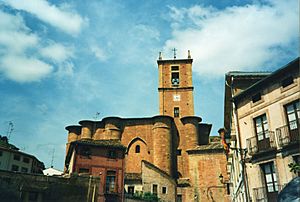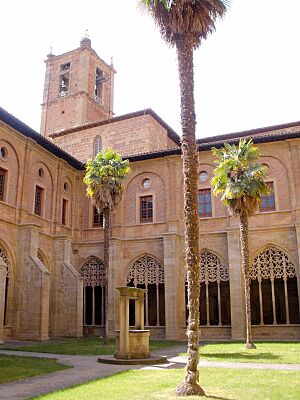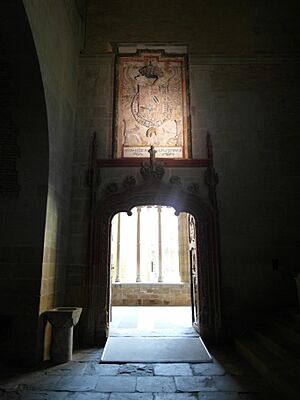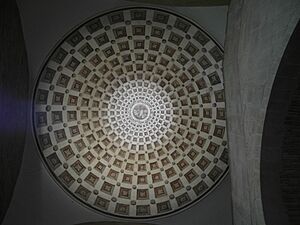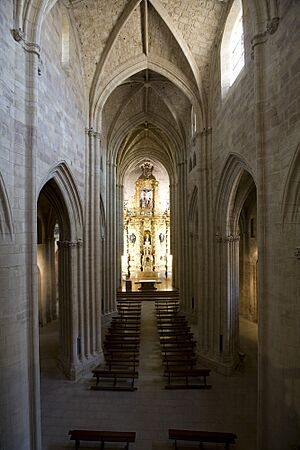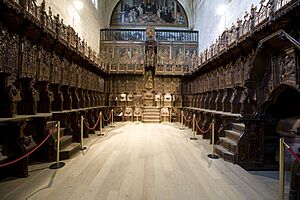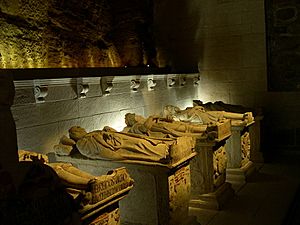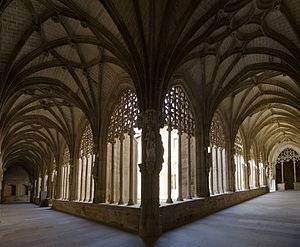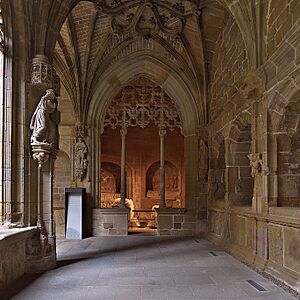Santa María la Real of Nájera facts for kids
The Santa María la Real monastery is a very old and important building in the small town of Nájera, located in the La Rioja region of Spain. It was first built by a king, making it a "royal foundation." Later, King Alfonso VI gave it to the Cluniac monks. This monastery was a key stopping point for people on the Camino de Santiago, a famous pilgrimage route. It is especially well-known for the beautiful wooden carvings found in the church's choir.
Contents
What is the History of the Monastery?
The first parts of the monastery were built way back in the 11th century. King García Sánchez III of Navarre founded Santa María la Real and a special burial place for royalty in 1052. Over time, it became an important church center, even getting direct permission from the Pope.
In 1076, the kingdom of Navarre came under the control of Alfonso VI of León and Castile. At this time, the old Spanish way of church services, called the Mozarabic Rite, was changed to the more common Latin Rite. An important old book called the Missal of Silos, which is one of the oldest paper manuscripts from the Western world, was created here in the 11th century.
How Did the Cluniac Monks Influence It?
In 1079, the main church office was moved to Calahorra. King Alfonso then gave Santa María la Real to the Cluniac order of monks. It became one of only two major Cluniac centers south of the Pyrenees mountains. The monastery helped bring the Cluniac way of life to Castile. This also helped King Alfonso strengthen his power in the Rioja area.
In 1142, Peter the Venerable, the head of the Cluny order, visited the monastery. While in Spain, he met with people who could translate from Arabic. He then asked for the first translation of the Qur'an into a European language.
The Cluniac monks managed the monastery until the 15th century. Then, the Pope made it an independent monastery under Rodrigo Borgia, who later became Pope Alexander VI. During this time, the monastery was rebuilt in a big way.
What Happened Later?
As fewer people walked the Camino de Santiago, the monastery became less wealthy. It slowly started to fall apart. In the 1800s, it suffered during the time when Napoleon's army was in Spain. It also faced problems from new laws that took away church property in the 1830s. However, in 1889, it was declared a national monument, which helped protect it. The monastery got a new start when Franciscan monks arrived at the end of the 19th century.
Exploring the Monastery Building
The outside of the Santa María la Real monastery in Nájera shows a mix of different building styles. This is because it has such a long history. It was built with high walls and strong supports, like a fortress, to protect it. In the 17th century, decorations were added to the walls and doors, and the square tower was built. The entrance to the church was built between 1621 and 1625.
Inside the monastery, you can see two main parts: the church with the Royal Mausoleum and the cloister, which is called the "Cloister of the Knights." You enter the cloister through the Gate of Charles I. This gate has a fancy, decorative style called flamboyant. Above it, there is a large coat of arms of Charles I with a double-headed eagle. This was put there to honor the king, who gave a lot of money to help build the cloister.
Next to the gate, you'll find the stairs that lead to the upper cloister. These stairs are in the Renaissance style. They are covered by a round dome decorated with paintings that create an optical illusion, called Trompe-l'œil. The main picture in the middle of the dome is a pelican. These stairs were built in 1594 and are known as the Royal Stairs.
The Church and Its Features
The first church, dedicated to the Virgin of the Cave, opened in 1052. It was built in the Romanesque style with some Mozarabic influences.
The church you see today was built between 1422 and 1453. It is in a style called "flowery Gothic," which means it has elegant but simple shapes. Most of the ceilings have simple ribbed vaults. The side areas at the back of the church are square, and the upper windows are almost triangular.
The inside of the church has three main sections, separated by 10 columns. Underneath the choir, you can find the entrance to the cave. This is where the image of the Virgin is believed to have been found, and this spot has stayed the same since then.
The main altar screen, called a reredos, is from the 17th century and is in the Baroque style. It has large, highly decorated Solomonic columns that look like twisted vines with grapes and leaves. In the center is a special room for the Virgin, with the original statue. It is surrounded by statues of the founders of the Benedictines, Saint Benedict and Saint Scholastica, and pictures of the founding kings. You can also see things believed to have been found with the Virgin: a jar with Madonna lilies (the monastery's symbol), a lamp, and a bell. Above these, a frieze tells the story of how King Don García discovered the Virgin. The altar screen ends with a scene of the Calvary.
In the left side of the church, there is a copy of the old main altar screen. Part of the original is now in a museum in Antwerp, Belgium. It was sold in the 19th century. The artist who made it was Hans Memling.
The Image of the Virgin
The statue that led to the building of this monastery is a medieval wooden sculpture. It is painted in many colors, but only on the front. It shows the Virgin Mary holding baby Jesus. She is giving a blessing with her right hand and holding a ball in the other.
The statue was repaired in 1948 by the Príncipe de Viana Institute.
An interesting fact: the Imperial State Crown, part of the Crown Jewels of the United Kingdom, has a ruby from a Virgin statue at this monastery. This ruby was taken to England by the Black Prince after he helped Peter the Cruel in his wars.
The Cave of Discovery
The cave where the Virgin statue was found is part of the church. There are many such caves around Nájera, and they have been used for different things over time. People believe this cave originally had a small chapel where the Virgin was worshipped. The story says that in 1044, the king was hunting with his hawk. Following his hawk, he found the Virgin statue in this cave, along with a bouquet of Madonna lilies, a lamp, and a bell. The king believed that the victories he had in wars against the Muslims after this discovery were because of the statue.
The original Virgin statue stayed in this cave until the main altar screen was built. Later, another carving from the Royal Alcázar chapel was placed here. This is the one you can see today, since 1845. This carving is from the late 13th century and was restored in 1998. Many important noblemen and religious leaders chose to be buried in this cave. Before the restoration work in the late 20th century, their tombs were on the floor of the building.
The Monastery Choir
The choir is a special part of the church. It has a set of wooden chairs in the Gothic style. These chairs were made between 1493 and 1495. The work was managed by brothers Andrés and Nicolás Amutio, and paid for by Abbot Pablo Martínez de Uruñuela. You can even see them pictured on the back of one of the chairs.
The carvings on the backs of the chairs and on the small shelves underneath (called misericords) are all different. They show religious symbols, scenes from everyday life, and important people from that time. The carving on the main chair for the abbot is very special, as it shows King García of Nájera.
Above the chairs are two large paintings. One shows a row of six pairs of kings, all identified. The whole choir area is topped with a Baroque painting of a Benedictine meeting. This area was very damaged after the monastery was abandoned in the late 19th century.
Royal Burial Places
Royal Mausoleum
At the front of the main church area, on both sides of the cave entrance, you can find the tombs of the kings of Nájera-Pamplona. This kingdom was the start of the Kingdom of Navarra. Here are buried kings from the Jimena dynasty, who ruled from 918 to 1076. Later, García Ramírez, who ruled from 1135 to 1234, was also buried here.
The stone tombs themselves were made later than the kings buried inside them. They are in the Renaissance style with some Plateresque details. The decoration is simple, with statues of the kings in their royal clothes on top of white stone burial boxes. This Royal Mausoleum was built around 1556.
Mausoleum of the Princes and Princesses
The burial place for princes and princesses, called the mausoleum of the infantes, is in the left side of the church. Here lie the remains of royal family members who did not become kings or queens. The most important tomb here is that of Blanca of Navarra. Only the lid of Blanca of Navarra's tomb remains, and it is the only original part of this set. It is from the 12th century and is a Romanesque piece. It has carvings that show scenes from the Gospels and from Blanca's life. She died at a very young age.
Mausoleum of the Dukes of Nájera
On the left side of the main altar is the mausoleum of the Manrique de Lara family, who were the Dukes of Nájera. This title was given to them by the Catholic Monarchs in 1482. The Dukes of Nájera ruled the city until 1600, when they had no more family members to take over. The most important tomb here is that of the first duke, Pedro Manrique III de Lara, known as the Strong. He was important in the court of Ferdinand II of Aragon. He fought with Ferdinand in the Granada War and later became the ruler of Navarra after it was conquered in 1512. Also buried here is Juan Esteban Manrique de Lara, who was the ruler of Navarra in 1521. He fought alongside Ignatius of Loyola in the siege of Pamplona.
Cloister of the Knights
The cloister was built between 1517 and 1528. It mixes the "flowery Gothic" style in its domes and pillars with the plateresque style in the stone patterns of its arches. Most of the gravestones on the wall tombs here are also in this style.
The cloister has 24 arches, each decorated with different stone patterns. These stone patterns are supported by slender pillars. The upper cloister was built above this level in 1578.
It's called the Cloister of the Knights because many noblemen chose this place for their burial. Of those tombs, only the ones in the walls remain. The tombs on the floor were removed during restoration because they were in bad condition.
The cloister was badly damaged when the monastery was abandoned and misused in the 19th century. Right now, only the lower cloister has been restored.
Chapel of Queen Mencía López de Haro
In one of the west corners of the cloister, you'll find the entrance to the tomb of Queen Mencía López de Haro of Portugal. She was the second wife of the Portuguese King Sancho II the Caped. When King Sancho died in 1248, Mencía returned to Nájera. She lived there until her death in 1272. Her sarcophagus is from the 13th century and is decorated with the coats of arms of Portugal and López de Haro. Next to Mencía's tomb are those of her brother and Garci Lasso Ruiz de la Vega, who died in the Battle of Nájera in 1367. This chapel used to house a very special statue of Christ.
Mausoleum of Diego López de Haro, the Good
The López de Haro family were important counts of Nájera and lords of Biscay. They held these titles from the time King Sancho the Great gave them until the 19th century.
The burial place of Diego López de Haro, known as the Good, is next to the church entrance. He was the 10th lord of Biscay (1170–1214). His tomb is at the front of the main church area, on the south wall of the cloister. At the foot of Don Diego's tomb is that of his second wife, Toda Pérez de Azagra, who died in 1216. The original stone boxes are Romanesque, but Renaissance decorations were added later. The carvings show burial scenes and people in 18th-century clothes.
Access Gate to the Church
The gate that leads into the church is a wonderful example of plateresque carving. It was made in the first half of the 16th century. It is decorated with round pictures, plant designs, and imaginary animals, all grouped in rectangular panels. It is carved from walnut wood.
See also
In Spanish: Monasterio de Santa María la Real de Nájera para niños


